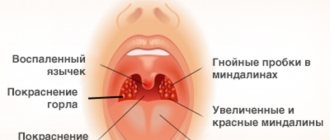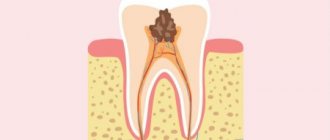The inflammatory process in the subgingival and subperiosteal jaw area with purulent formation (abscess) is called gumboil or periostitis. Its main cause is inflammation of the tooth root. A visual sign of the disease is a swollen cheek (a “bump” forms in the problem area).
Most of us prefer to treat flux on the gums at home, but periostitis is a fairly serious disease, the absence or untimely treatment of which poses a threat to the health of the entire body. In the article we will talk about the symptoms, causes of periostitis, and how to cure gumboil.
Flux: symptoms, causes of appearance
Characteristic symptoms of flux:
- swelling of the gums and face;
- pain in the area of the tooth that caused inflammation;
- enlargement and hardening of lymph nodes in the neck and head;
- general malaise: weakness, fever up to 38 degrees, headache.
Three stages of development of periostitis can be distinguished:
- at the first stage, pain occurs that bothers you when eating (due to contact with the site of inflammation);
- the gums swell, a “bump” appears, in which pus subsequently accumulates;
- swelling of various parts of the face (lips, cheeks, chin) occurs, the temperature may rise to 38 degrees, the pain radiates to the ear and visual organs.
The main reasons for the development of flux:
- advanced caries;
- complications after poorly performed treatment of pulpitis;
- gum injuries;
- hypothermia;
- jaw injuries;
- flux after tooth extraction;
- complications after flu or sore throat;
- inflammation of the gum pocket.
The following types of fluxes are distinguished:
- Ordinary. Pathogenic bacteria do not take part in the inflammatory process, but infiltration of the periosteum occurs.
- Fibrous. A chronic form of gumboil that develops as a result of exposure to irritants on the gum tissue. Thickening of the periosteum occurs.
- Purulent. It develops as a result of damage to the gums through which pathogenic bacteria penetrate. Often combined with purulent osteomyelitis.
- Ossifying. Develops as a result of prolonged irritating effects on the periosteum. Chronic illness.
- Serous. Periostitis with less pronounced symptoms develops quickly, but goes away within 2-3 days.
Antibiotics
Antibiotics are necessarily prescribed for tooth flux. Since the contents of the abscess are represented by a wide flora of strains of anaerobic, aerobic, gram-negative and positive microorganisms, broad-spectrum preparations are needed.
"Amoxiclav"
It is active against most bacteria and microbes. Penetrates into all organs and is excreted by the kidneys in an almost unchanged form.
Important! "Amoxiclav" is prohibited for adolescents under 12 years of age, with liver diseases, and jaundice. During pregnancy it is prescribed with caution.
Amoxiclav costs 250 - 300 rubles.
"Lincomycin"
In small doses it has a bacteriostatic effect (suppresses the activity of pathogenic microorganisms), in high doses it has a bactericidal effect (leads to the death of microbes).
"Lincomycin" is considered a "dental" antibiotic. It is often prescribed for the treatment of inflammatory diseases of the gums and teeth, as it can accumulate in the periosteum.
The basis of treatment is antibacterial therapy.
The drug is relatively safe and is prescribed to infants over 1 month of age. Sometimes it can cause digestive upset and allergic reactions. The medication should not be prescribed for serious disorders of the liver and kidneys, or for pregnant and lactating mothers.
“Lincomycin” costs about 200 rubles.
Important! Only a doctor prescribes the type of antibiotic, dosage and duration of use. Self-medication leads to bacterial resistance and complications.
Let's talk in more detail about the main types of fluxes.
Acute serous periostitis. As we wrote above, the inflammatory process occurs quickly and passes within a few days. It is characterized by severe swelling of the soft tissues. It is localized directly on the area with the diseased tooth, which is the main reason for the development of gumboil. The degree of inflammation depends on the structure of the vessels in the periosteum. The cause of the development of an acute form of serous flux can also be bruises and fractures. In this case, periostitis is called traumatic or post-traumatic. Most often it goes away on its own, but in some cases it can cause severe inflammation and the development of another type of flux - ossifying (fibrous growth).
Acute purulent periostitis. This type of gumboil is characterized by severe pain, which is often pulsating and spreads to the organs of vision and hearing, causing migraines. Pain is managed with medications and cold compresses. You should not heat the swelling site - this can lead to increased pain.
Purulent flux occurs with an increase in temperature to 37.5-38 degrees, the patient develops weakness and general malaise. It should be noted that the course of the disease depends on the location of the inflammation: in the lower jaw the process is more complicated.
The localization of inflammation depends on the location of the lesion:
- 1
Maxillary incisors - an inflammatory process on the upper lip and can spread to the nose. - 2
Maxillary canines and premolars - an inflammatory process in the periosteum.
- 3
Molars - an inflammatory process in the upper part of the cheeks.
- 4
Premolars - inflammation is localized in the lower part of the cheeks.
Chronic periostitis. The rarest form, which is usually localized in the periosteum of the lower jaw. In the chronic course of the disease, local inflammation is present, which does not change facial features. Characteristic symptoms are swelling in the mouth, enlargement of the periosteum, and lymph nodes. The development of this type of periostitis is a long process that takes from 4 to 8 months.
Ointments and gels
Along with antiseptic rinses, ointments and gels are prescribed for periostitis. They also disinfect wounds, draw out pus and relieve swelling. In addition, the drugs have a reparative effect and accelerate healing.
Pharmacy products
The best option is to use medicated flux gels. They include strong antiseptic and antibacterial components that are tens of times superior to plant ones. Their cost is affordable and there is no need to waste time preparing homemade balms.
"Metrogil-Denta"
The gel is specially designed to eliminate dental problems: inflammation and gum disease (gingivitis, periodontal disease, periodontitis), stomatitis, cheilitis, periostitis. It is also used for teething, injuries caused by braces and dentures.
"Metorogil-Denta" is a combination drug based on chlorhexidine and metronidazole. It is not absorbed, does not penetrate the bloodstream and affects only pathogenic microorganisms and does not affect beneficial bacteria.
Contains chlorhexidine and metronidazole.
Important! The gel occasionally causes allergic reactions. It is contraindicated in the 1st trimester of pregnancy, during breastfeeding, and in children under 6 years of age.
The product is available in tubes of 5, 10 and 20 g. The average price for Metrogyl Denta is 250 rubles.
"Levomekol"
"Levomekol" based on the reparant methyluracil and the antibiotic chloramphenicol. The latter is active against most bacteria, microbes and viruses. It is extremely rare for pathogenic microorganisms to develop resistance to it. It is effective against many strains that are not affected by penicillin, sulfonamides, and streptomycin.
Additional Information! Chloramphenicol is on the list of the most important and vital drugs.
I use the gel for flux only externally. It is applied pure to the gums or lubricated with a tampon and made into a lotion. Levomekol costs about 100 rubles.
Contains an antibiotic.
Home methods
Dental swelling can also be reduced with homemade ointments. Their main advantage is the absence of contraindications with the exception of hypersensitivity.
Calendula cream
Dried flowers are mixed with melted butter in a concentration of 1:5. Apply flux overnight and 2-3 times during the day.
Beeswax mixture
Heat 3 tbsp in a water bath. linseed and olive oil. Add 25 ml of honey and 50 ml of beeswax. Melt, cool and apply to the tumor with a cotton swab.
The wax is melted in a water bath.
Flux diagnostics
The diagnosis of “periostitis” can only be made by a specialist. In order to identify the disease at an early stage, you will need to visit the dentist's office. Therefore, if such primary signs as hyperemia, accumulation of infiltrate, etc. are detected, we recommend immediately consulting a doctor for diagnosis. If an odontogenic type of periostitis develops in the mouth, then there is almost always a decayed tooth in the oral cavity, which is the cause of the pathogenic process.
Diagnosis is made using fluoroscopy. If the disease is in an acute stage, then it will not be possible to determine changes in the shape of the jaw using this research method, but it can be used to identify granulating periodontitis, which is a catalyst for the development of the inflammatory process.
Prevention
Understanding what gumboil is, you need to monitor the condition of your teeth and gums. Prevention consists of following hygienic rules for caring for the oral cavity. It is important to buy a quality toothbrush and good toothpaste to minimize the risks of developing caries. You need to brush your teeth twice a day: morning and evening.
After eating, it is necessary to remove food debris from the interdental spaces and use a mouth rinse to treat the oral cavity. To do this, you can buy the product at the pharmacy or prepare it based on propolis tincture, sea or table salt.
It is important to visit the dentist twice a year for preventive examinations. All diseases at the initial stage are successfully treated. Tartar should be removed regularly. It is in these deposits that pathogenic bacteria multiply, which, if the soft gum tissue is accidentally injured, can cause the development of gumboil.
To strengthen your gums, you must include fresh fruits and vegetables in your daily diet: apples, carrots, etc. They clean plaque on tooth enamel, which reduces the likelihood of tartar formation.
Tooth flux - what to do?
The most popular search on the Internet: “how to get rid of gumboil”, “how to remove gumboil from a tooth”, “removing gumboil at home”. If you detect even the slightest signs of flux, we recommend seeking help from a doctor. Flux on the cheek is a pathological process that requires mandatory treatment, which will avoid serious complications, including conditions that threaten the patient’s life.
If signs of flux suddenly appear, before consulting a doctor, you can perform procedures that will help reduce swelling. But they should be considered as a temporary remedy to alleviate the patient’s condition.
How to rinse with flux? The following solutions can be used to relieve pain:
- Alcohol tincture of calendula. A teaspoon of the product is mixed in a glass of water. The resulting solution is used to rinse the mouth.
- Infusion of green tea and sage. To do this, use a teaspoon of sage and green tea in a glass of water. The herb is poured with boiling water and infused for 20-30 minutes. You should regularly rinse your mouth with the resulting solution.
- Mint and lemon balm leaves. The herb is poured with boiling water and left for 3-4 hours. The resulting infusion is used to rinse the mouth.
Anti-inflammatory drugs
You can quickly relieve swelling and reduce pain at home with flux using anti-inflammatory non-steroidal drugs. They are available in the form of tablets, suspensions, and powders.
"Nimesil"
The main anti-inflammatory “dental” remedy. The main component is nimesulide. It has a strong anti-edematous, anti-inflammatory effect, and to a lesser extent – antipyretic and analgesic. These properties make Nimesil the No. 1 drug in the treatment of periostitis.
The main component is nimesulide.
The medicine is prescribed for adults and children over 12 years of age, 1 sachet twice a day. It is not recommended for patients with disorders of the intestines, liver, heart or during pregnancy.
The price of one sachet of “Nimesil” is 20–30 rubles.
Flux - treatment in a dental clinic
The choice of treatment method for flux depends on the type of periostitis, its severity, and the individual characteristics of the body. In the acute form, the nerve is removed, the wound is opened and cleaned, treated with antiseptics, and antibiotics are prescribed.
To defeat purulent flux in an adult, they resort to a more comprehensive treatment program. In this case, additional procedures may be prescribed, as well as complex antibiotic therapy.
Regardless of the type of periostitis (excluding the chronic form of flux), a mandatory step is a course of antibiotics, which is selected individually. As a rule, with the right course of treatment, the flux goes away within 7-10 days (stable positive dynamics of recovery are recorded on days 3-5). In the chronic course of the disease, the tooth after gumboil is usually removed.
Let us remind you once again that by refusing professional help, you risk your health. Without the participation of a doctor, there is a high probability of the formation of a gingival fistula, the penetration of pus into nearby tissues, which causes the development of phlegmon.
How to treat flux in a child?
Quite often, parents ignore the fact that they have baby teeth affected by caries, reassuring themselves that permanent teeth will soon grow in their place. However, an infected gum can cause gumboil to develop. The child’s body does not always react to periostitis with an elevated temperature, and the only symptom may be minor pain, which is not given any importance. The immunity of children is weaker than that of adults, so the disease progresses quickly.
In order to prevent complications, it is necessary to begin treatment at the first sign - clean the canal, close the hole in the tooth with a filling.
FAQ:
How to rinse the flux to make it break out?
As we wrote above, any procedures cannot replace consultation and treatment in a dental clinic. Before visiting a doctor, in order to alleviate the condition and reduce swelling (edema), you can rinse your mouth with various antiseptic and antimicrobial agents, for example, chlorhexidine. Additionally, you can use sodium saline solution, sage decoction, and calendula tincture.
The flux has burst - what to do?
If the flux has burst, the time before visiting the doctor can be used to carry out simple procedures on your own. First of all, you should rinse your mouth with clean water at room temperature. You can do this using a soda solution - to do this, you need to dissolve a teaspoon of soda in a glass of warm clean water. It is advisable not to eat before being examined by a doctor.
What to do to prevent flux?
The best prevention of flux is regular hygiene procedures in the oral cavity and timely treatment of foci of chronic infection.
Do not forget that gumboil may not go away on its own, turning into a chronic disease, and given that it poses a serious danger to human health, we recommend that you do not hesitate to contact a dental clinic. Only here is reliable diagnosis and effective treatment possible. Be healthy!
Content:
- Causes of pathology
- Symptoms
- How to rinse with flux - the simplest and safest recipe
- Pharmacy products for flux processing
- Folk recipes
- Why you can’t treat gumboil yourself
- How do doctors treat flux?
Periostitis of the jaw or gumboil is a dangerous dental disease.
It is caused by an infectious-inflammatory process localized in the tissues of the periosteum. The disease should be treated under the supervision of a dentist. The doctor will carry out the necessary antiseptic measures and tell you what to rinse your mouth with gumboil, and select antibiotics.
Self-medication for periostitis is most often ineffective. Moreover, as long as the patient experiments with different folk recipes, the inflammatory process will continue to spread. This will lead to premature loss of the unit - partial edentia.
Remember: rinsing with flux is not a panacea, but only an auxiliary technique. There is no need to focus on it. Treatment of the disease must be comprehensive.











